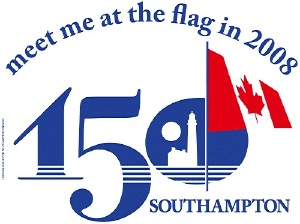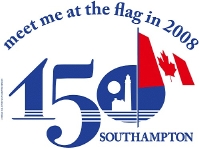|
Historical captions from the 150th Anniversary calendar
September 2007 - Fairy Lake
Today Fairy Lake is an oasis of quiet where you can explore the natural beauty along the perimeter path or listen to music at the bandshell on a Sunday. But over a century ago this was an industrial site. In 1880 Isaac Bowman and Henry Zinkan built a tannery on the shore of Little Lake, as it was then known. By 1888 the tannery employed 20 to 25 people. It grew to become Southampton's major employer, until a fire destroyed it on July 31, 1900, throwing 100 out of work. Houses were built on the site, called Tannery Hill, where you may still pick up pieces of tanning bark and burnt leather.
October 2007 - Shipwreck
In April 2001 the timbers of a shipwreck were found poking out of the beach sand, between Morpeth and Palmerston streets. Marine archaeologist Ken Cassavoy identified the wreck as the British naval brig HMS General Hunter, built in 1806. The Americans captured her in the Battle of Lake Erie during the War of 1812 and used her as a transport on the upper Great Lakes until, on Aug. 19, 1816, she was wrecked on Southampton beach in a violent storm. The hull was fully excavated in 2004, then reburied to preserve it. You may see some artifacts, like a small cannon, at the General Hunter display at the Bruce County Museum and Cultural Centre.
November 2007 - Trains
V.A. Gilbert's "Union Bus No. 1" awaits passengers at the station (now Grosvenor's Restaurant), about 1910. The Wellington, Grey and Bruce Railway (later the Grand Trunk Railway) reached Southampton in 1872. The train brought in tourists and lumber, and took out crates of fish on ice and goods from the furniture factories. A spur line ran onto the Short Dock to serve ships in the Harbour of Refuge. CN ended passenger service in 1970 and freight in 1980. The right-of-way lives on as the Rail Trail, used for hiking, biking, cross-country skiing and snowshoeing. The Rail Trail Association plans to mark the spot where two trainmen died in the 1954 derailment caused when Hurricane Hazel's rains weakened the track bed.
December 2007 - Aerial
How Southampton has grown since John Spence and William Kennedy settled in 1848 ... this early 1900s view portrays the Victoria St. Bridge crossing the Saugeen, the downtown and, in the distance, Chantry Island. Curving round from Chantry is the Island Dock, then The Gap and the Long Dock, a massive timber breakwater finished in 1877. When Huron storms threatened, ships raced for The Gap and the shelter of the Harbour of Refuge. Just south (left) of the Long Dock is the Short Dock, where ships unloaded. The Long Dock proved to be popular for fishing and evening strolls, too, but storms got the better of it, gradually reducing it to rubble in the 1940s, leaving only shadows in the water (inset).
January 2008 - Winter
From the early days of Southampton until well into the 20th century, before the invention of refrigerators and freezers, 250-pound blocks of ice were sawed out of Fairy Lake and Miramichi Bay and stored in ice houses, insulated by straw and sawdust. All through spring and summer, the iceman supplied fish houses, butchers, ice cream parlours, hotels and private homes. The average household wooden fridge held a 25-pound block of ice, which sold for 15 cents delivered and lasted about three days. The ice harvest drew crowds; children were warned not to skate or play hockey on Fairy Lake because of the large holes left by the cutters.
February 2008 - Factories
The Southampton economy relied on fishing early on, later supplemented by a sawmill, foundry and tannery. In the 20th century furniture makers multiplied. Prominent names were Knechtel (above, in 1906), Hepworth, Southampton, Bell, Fitton-Parker and Sklar-Peppler. They brought in lumber by boat and train, and turned out fine furniture for the Ontario market.
March 2008 - River Harbour
An undated postcard shows Saugeen River Harbour, perhaps about 1910. The south pier is dominated by great warehouses and fishing sheds, flanked by fishing nets drying on their reels. In the 1880s, according to Picturesque Canada, the fish were plentiful: in the lake, salmon trout, whitefish, lake herring, lake sturgeon and gar; and in the rivers and creeks, bass, perch and spotted trout. Here at the mouth of the Saugeen the fishing fleet is moored, both traditional sail fishing boats and steam tugs with their smoke stacks, as the age of sail yields to the age of steam. Today the diesel engine reigns, and commercial fishing continues, along with pleasure boating. The range light on the north pier (inset) was built in 1904.
April 2008 - Sports, Summer
Southampton has always been a big sports town, with many fans of baseball, lacrosse, lawn bowling, curling, hockey, golf and tennis. 80 years ago a first-class baseball club, the Southampton Fishermen, competed in the Bruce League of the Intermediate Division, Ontario Baseball Amateur Association. Southpaw pitcher Hector (Hec) Goldsmith (bottom right, in 1932) led the team to two Intermediate OBAA championships, in 1932 and 1933. The Fishermen were backed by A. Fred Bowman, Southampton's only known millionaire. Unfortunately he was hit in the eye by a foul ball, seriously damaging his sight. He still supported the team afterward. (Inset) From atop the water tower, Doug Hills photographed a Southampton Fishermen game at Victoria Park, Sept. 3, 1934.
May 2008 - Lighthouse
What could be more pleasant than an outing to Chantry Island lighthouse, with sunhats, the kids and the Chantry Island flag? It's a spot imbued with history. Ever since the lighthouse beacon first shone in 1859, it has guided sailors past treacherous shoals and into safe harbour. Duncan Lambert and his son William kept the light until 1907 and are credited with many rescues of shipwrecked mariners. An army of volunteers from the Marine Heritage Society has restored the lighthouse, the keeper's quarters and the boathouse. Today you may take your sunhat and the kids on a boat tour to the island, just like a century ago, ascend the 86-foot tower and enjoy the view of the island and its bird sanctuary.
June 2008 - Beach - life-saving station
The charms of the beach at Southampton draw residents and visitors alike. But lurking offshore are shoals where many a mariner has come to grief. A century ago it was agreed that a "first-class life boat" was needed because of "frequent accidents occurring to vessels on our coast." And so the government life-saving station (inset) was built on the beach in 1908, near the foot of Palmerston St. It had a 100-foot runway for launching the 27-foot lifeboat. In 1918 the station was moved on rollers from the beach onto the Long Dock, several hundred yards out from shore. It fell into disrepair and was closed in 1937 and then moved ashore, where it is now a handsome house at 20 Beach Street.
July 2008 - High Street
A parade through downtown Southampton -- perhaps on July 1 -- is so popular that there seems to be more participants than onlookers. Unusual among Ontario towns, Southampton's main business street is not called Main Street, but High Street, in the British fashion. The 1851 town plan called for notably wide streets, including a principal street 150 feet wide. Not only is there room for angle parking, but if the occasional delivery truck should unload in the middle of the street, the traffic flows about it on either side.
August 2008 - Beach - willow tree
The beach at Southampton has always been an integral part of the town and a major attraction for generations of cottagers and residents, not forgetting the thousands of summer visitors ... tourism is a mainstay of the local economy. Southampton's unspoiled sandy beach stretches for kilometers, backed by sand dunes and native dune grass. The beach features many benches along the boardwalk, for contemplation of Chantry Island and its restored Lighthouse and Keeper's Quarters. It's the perfect setting for a romantic stroll, a leisurely swim, tanning or building sandcastles. Experience the lovely view from a kayak or canoe, cast a line and fish for salmon, or photograph the sunset.
September 2008 - Sunsets
Take one golden beach facing west, add one sun sinking into Huron blue, sprinkle a few sparkles of Southampton magic, and, presto, the perfect sunset. Subject of thousands of photographs over the years, Southampton sunsets are reputed to be among the most beautiful in the world. So say yes when you hear that invitation, "The sun's setting ... let's go down to the beach!". Thousands of photographers can't be wrong.
October 2008 - Bridges
A fine bridge carries Highway 21 over the Saugeen River, linking the two parts of Southampton. Previous spans had their ups and downs. A bridge at Denny's Dam was built in 1865 but spring floods were its undoing many times. It was washed out in 1907 and rebuilt in 1908. In 1909 an abutment washed away and the bridge was closed for repairs. In April 1912 floods took out one span. To bring more trade into downtown, a second bridge was built downriver from the dam in 1889, at Victoria Street (inset). In 1909 that bridge was judged unsafe and repairs began. In April 1912 it fell into the river. From April to June 1912 the town had no bridge at all; punts were used.
November 2008 - Boardwalk
A coloured postcard view of the boardwalk along Southampton's beach, looking north toward Palmerston St., shows that electricity has arrived. Visible at left is the government life-saving station, built in 1908, with its long ramp running down into the water. For strolling, people-watching and sunset-viewing, the boardwalk is ideal. It started life as a wooden walkway in 1895, but the planks squeaked considerably, it is said. The townspeople replaced it with a concrete walk in 1906, thanks to the proceeds from an amateur production of a Gilbert and Sullivan opera, which explains why people for years afterward called the promenade The Pinafore.
December 2008 - Sports, Winter
Men's Hockey, 1921-22
Top: W. Howke, M. McIver, B. Stevenson, V. McLellan, F. Wilson, J. Campbell
Bottom: A. Huber, R. Knowles, K. Matheson, R. Trelford, O. McKaney
Men's Curling, 1906
The winning rink at the 1906 Owen Sound Bonspiel.
Boys' Hockey, 1948-49
First championship to Southampton in 15 years.
Top: James Rourke, Max Davies, Bill Rourke, Doug Huber, Ab Rourke, Larry Smith
Middle: Allan Brown, Art Knechtel, Bob Shultz, Joe Longe, Dick Wentworth, Art Eby, Gordon Walmsley
Bottom: Jim Mahon
More links
 Southampton, Then and Now: historical calendar Southampton, Then and Now: historical calendar
 See the summary of Important dates in Southampton history (1816 to 1993). See the summary of Important dates in Southampton history (1816 to 1993).
 The news release announces publication of the calendar. The news release announces publication of the calendar.
 Top Ten Things You Won't Know About Southampton Top Ten Things You Won't Know About Southampton
... Unless You Get The 150th Anniversary Calendar
 The people on the 150th Anniversary organizing committee are all volunteers. The people on the 150th Anniversary organizing committee are all volunteers.
 See the online list of 150th anniversary events, or pick up the Events Flyer at the Chamber of Commerce and at various locations around Southampton. See the online list of 150th anniversary events, or pick up the Events Flyer at the Chamber of Commerce and at various locations around Southampton.
|
|
|



 southampton150info@saugeenshores.ca
southampton150info@saugeenshores.ca www.saugeenshores.ca/southampton150
www.saugeenshores.ca/southampton150